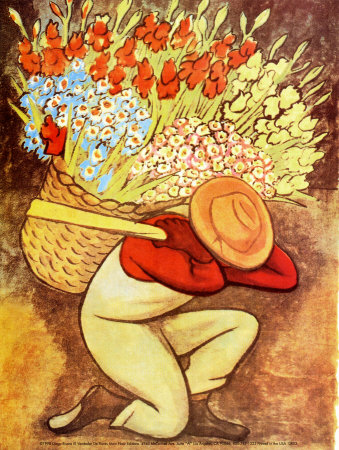DIEGO E A MULHER FRIDA
From Wikipedia, the free encyclopedia
Born December 8, 1886 Guanajuato, Guanajuato, Mexico
Died November 24, 1957 (aged 70) Mexico City, Mexico
Nationality Mexican
Field Painting, Muralist
Training San Carlos Academy
Movement Mexican Mural Movement, Social Realism
Influenced by Pablo Picasso, Georges Braque, Paul Cézanne, Glenn Gant
Diego María de la Concepción Juan Nepomuceno Estanislao de la Rivera y Barrientos Acosta y Rodríguez (December 8, 1886 – November 24, 1957) was a prominent Mexican painter born in Guanajuato, Guanajuato, an active communist, and husband of Frida Kahlo (1929–1939 and 1940–1954). His large wall works in fresco helped establish the Mexican Mural Renaissance. Between 1922 and 1953, Rivera painted murals among others in Mexico City, Chapingo, Cuernavaca, San Francisco, Detroit, and New York City.[1] In 1931, a retrospective exhibition of his works was held at the Museum of Modern Art in New York City.
Diego Rivera was born in Guanajuato, Guanajuato, to a well-to-do family. Rivera was descended from Spanish nobility on his father's side. Diego had a twin brother named Carlos, who died two years after they were born.[2] From the age of ten, Rivera studied art at the Academy of San Carlos in Mexico City. He was sponsored to continue study in Europe by Teodoro A. Dehesa Méndez, the governor of the State of Veracruz.
After arrival in Europe in 1907, Rivera initially went to study with Eduardo Chicharro in Madrid, Spain, and from there went to Paris, France, to live and work with the great gathering of artists in Montparnasse, especially at La Ruche, where his friend Amedeo Modigliani painted his portrait in 1914.[3] His circle of close friends, which included Ilya Ehrenburg, Chaim Soutine, Amadeo Modigliani and Modigliani's wife Jeanne Hébuterne, Max Jacob, gallery owner Leopold Zborowski, and Moise Kisling, was captured for posterity by Marie Vorobieff-Stebelska (Marevna) in her painting "Homage to Friends from Montparnasse" (1962).[4]
In those years, Paris was witnessing the beginning of cubism in paintings by such eminent painters as Pablo Picasso and Georges Braque. From 1913 to 1917, Rivera enthusiastically embraced this new school of art. Around 1917, inspired by Paul Cézanne's paintings, Rivera shifted toward Post-Impressionism with simple forms and large patches of vivid colors. His paintings began to attract attention, and he was able to display them at several exhibitions.









Sem comentários:
Enviar um comentário